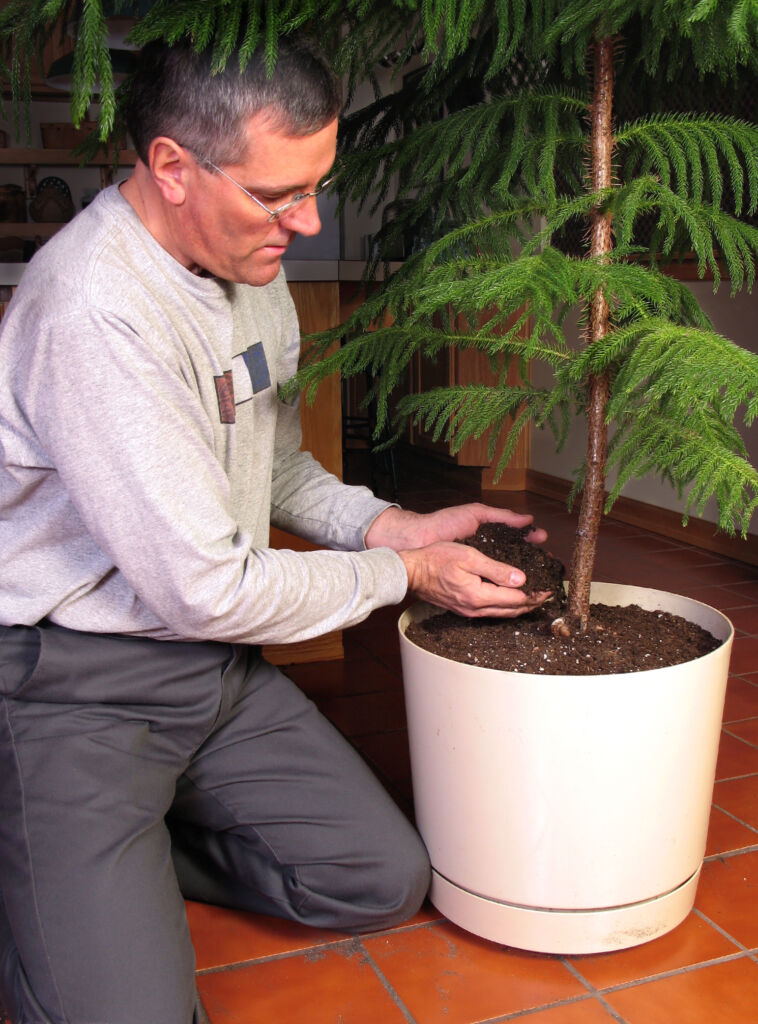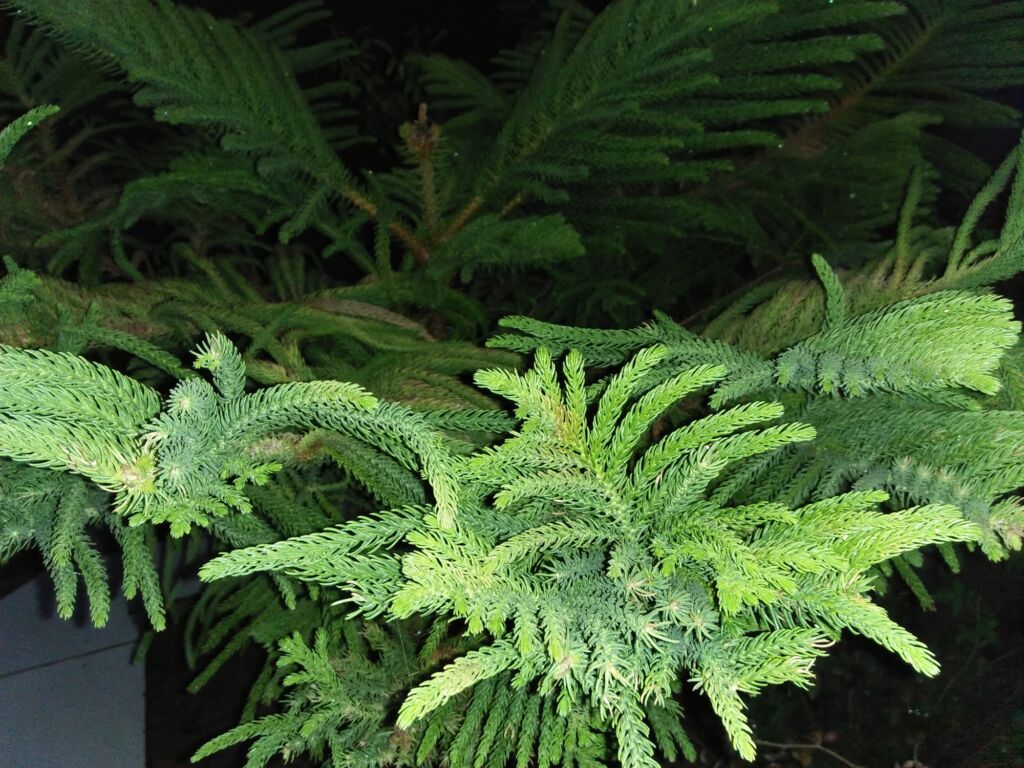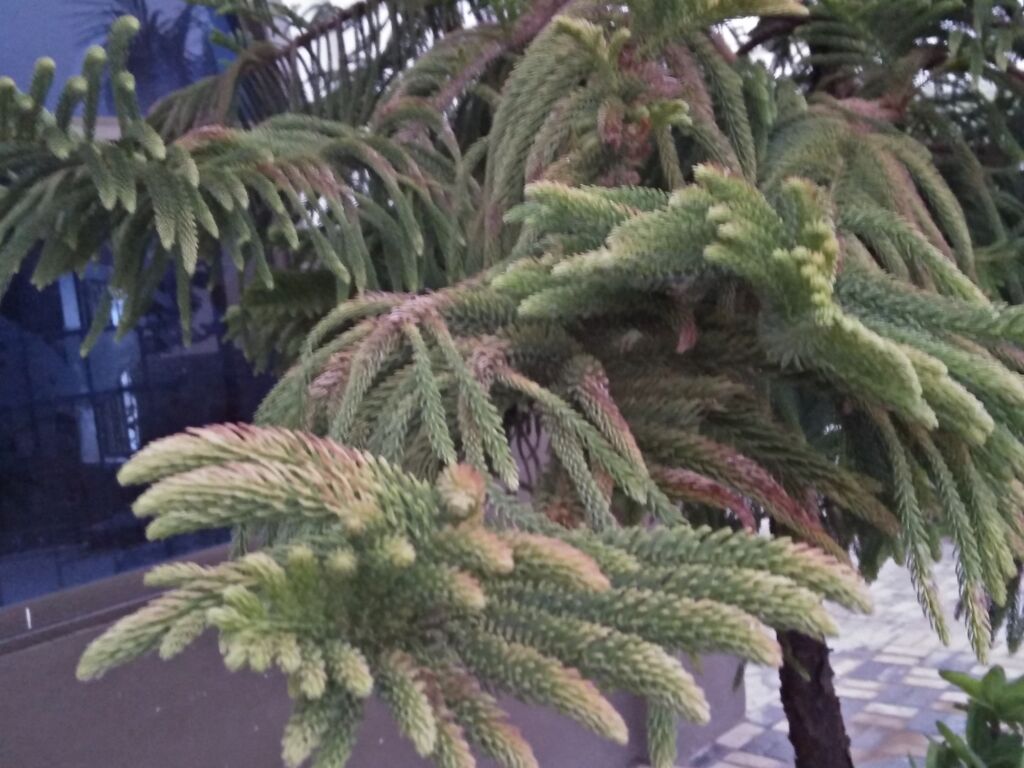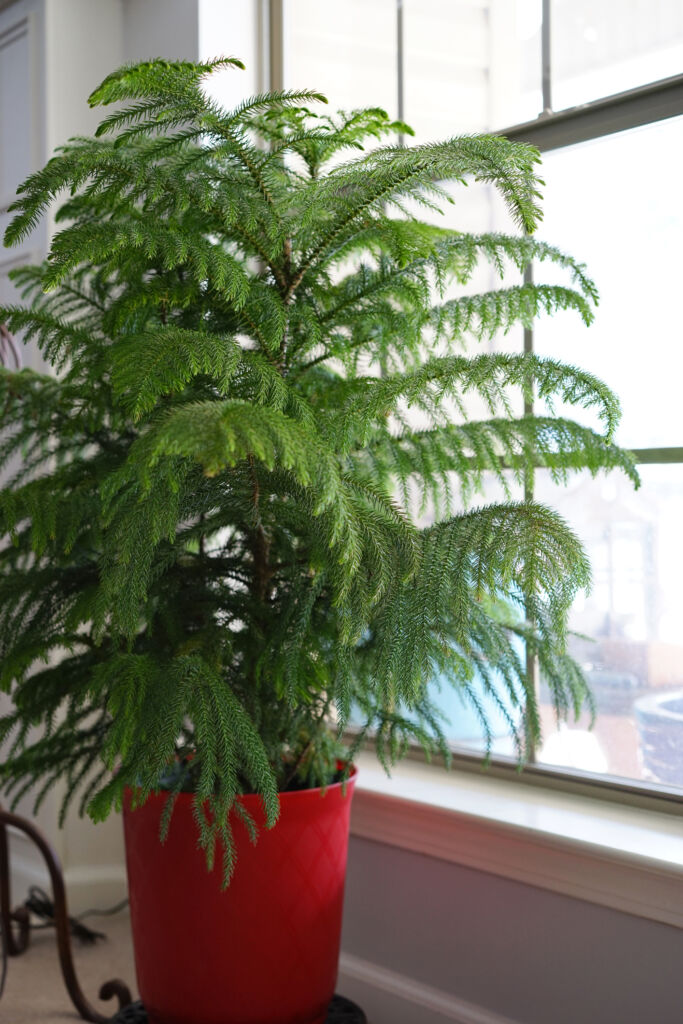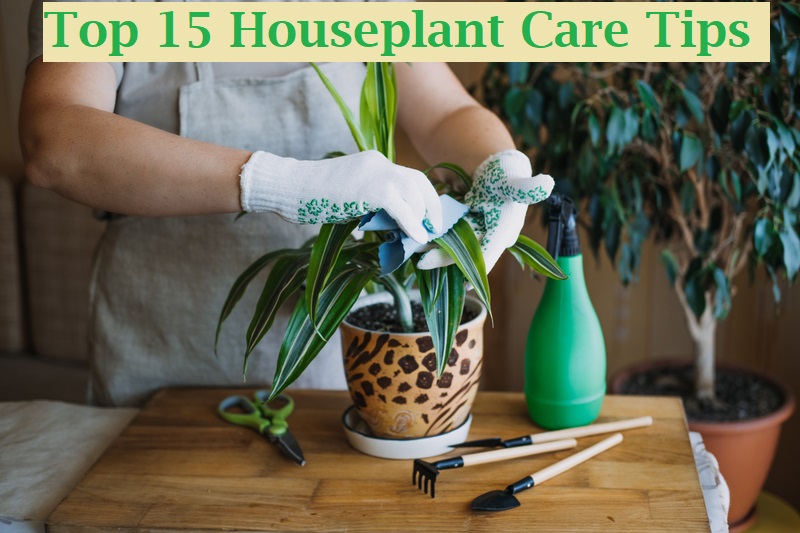HousePlantJoy is supported by our audience. When you purchase through one of our links, we may earn a small affiliate commission. As an Amazon Associate I earn from qualifying purchases. Your cost is not affected.
==================
Caring For The Norfolk Island Pine Houseplant
Homeowners have a Norfolk Island Pine houseplant for good reasons. The fancy plant for interior design can give a home a touch of nature. As an evergreen plant, people can enjoy its company one season after another. So you can have it at Christmas and other times of the year. It comes with a single upright trunk with wide-spaced offshoots in concentric circles. It also has curved conifers that resemble scales. Still, after a decade or more, it produces cones. It’s low-maintenance and appeals to busy people too. Hence, it’s hardly surprising why many folks prefer and recommend it.
This indoor tree looks fascinating, pleasant, and festive. It doesn’t ask for a lot of attention to thrive. Thus, it can be the ideal plant for beginners to have an ornamental garden companion inside. In this post, we’re going to explore more about this charming indoor tree.
What Makes Norfolk Island Pine Houseplant Unique
Called Heterophylla, it’s a subtropical plant that is not considered a pine tree. It’s different because of the conifers as its foliage. Compared to other pines, it’s a plant that does well in warm and humid environments. After all, it’s native to an island in the South Pacific Ocean. The place where it got its name has a mild climate and steady weather throughout the year. Also, it belongs to the Araucariaceae family. It means it’s from a line of ancient trees that traces back to the early Jurassic period. Plus, they are dioecious or can have male or female cones. With these things alone, they make pretty interesting plants to keep.
When left to thrive in an environment with ideal growing conditions, it can grow up to 60 feet high. There are even others that have reached steeper heights. It can become a compact and decorative plant when grown inside a house. Many use it to celebrate the holiday since it resembles conventional pine trees. With its evergreen species, it in represents eternal life in Christian belief. It’s why it’s available at Christmas time too. The silhouette of a mature tree outdoors is even on the Norfolk Island Flag. The symbolism expresses the endemic nature and fertility of the territory. So, due to its many positive attributes, folks consider it a notable tree worth owning.
Norfolk Island Pine Houseplant Light Requirements
This ancient plant is very flexible when it comes to light. Native to the subtropics, it can thrive in low, average, and beaming sunlight. Several hours of direct or indirect sunbeam will make it survive. Some gardeners expose it to sunshine for three to four hours a day. They put this houseplant in a room with a window facing south. When outdoors, people place it in shaded spots for indirect natural light. Long hours of direct sunlight will cause its leaves to turn brown and crispy. Others give their tree two hours of daylight and fluorescent light when it’s dark. This strategy helps divide photosynthesis and lessen the stress on a plant. Yet it may not survive on a steady yet faint glow alone. So taking care of the Araucaria Heterophylla doesn’t demand many changes.
Another reason why this tree does well with indirect sunlight is that such keeps it cool and moist. When its soil turns dry, its leaves may begin to discolor and wilt. Besides, this plant can have ample light with an indirect sunbeam. It’s only a matter of moving to where there’s a steady source of partial light. Transferring indoor Norfolk Island Pina houseplants outside may be necessary during summer. Exposing it to auxiliary or grow lights would be best in wintertime. Yet it doesn’t call for constant moving. Thus it requires specific light conditions but isn’t tiresome to handle.
Moisture Requirements Of Norfolk Island Pine Houseplant
Watering and air humidity come to mind with this concern. Hydration is crucial to and must be correct for the Araucaria Heterophylla. Even if it doesn’t ask for constant watering, it must have water weekly or every other week. But consider the room humidity and soil moisture before misting or pouring water. Too much water can cause the roots to rot and the foliage to fall off. Yet we shouldn’t worry much about this plant staying indoors. It tolerates some drought and salty environments. As long as its soil and container drain well, there shouldn’t be issues. It’s enough to get an inch of its topsoil wet and keep it dry between watering. So it’s a plant that is manageable when it comes to hydration.
If it isn’t too humid indoors, do something about it. Line the base of your plant’s container with pebbles. With them around, there would be things that can enrich the air humidity. Water evaporates from them when it gets warm inside. Also, there are electronic humidifiers that can help with indoor water vapor. The key is to keep track of your plant’s foliage. Inspect the conifers so that they don’t turn brown. If parts of your plant start slumping, you can cut back on the watering. Hence, remember to keep watering but don’t overdo it. Get a hygrometer and try to see the wetness of the soil by hand too.
Temperature For The Araucaria Heterophylla
The Norfolk Island Pine houseplant likes being in warm and humid places. Endemic in a subtropic zone, this plant thrives where it’s 60 to 70 Fahrenheit or 15 to 21 Celcius. In cold climates, moving it indoors is necessary for wintertime. Putting it far from windy areas outdoors is crucial too. It grows well in rooms with draped windows and a nearby heater during winter when inside. The point is that it cannot tolerate extreme freezing. Because of these things, it’s best to be mindful of the indoor temperature when caring for this plant.
Putting it away from drafty areas like windows and doors is helpful when it gets cold. But check its branches for signs of weakness too. Soft offshoots often show overheating.
Norfolk Island Pine Houseplant Fertilizer And Soil
Like other trees, the indoor Araucaria Heterophylla needs fertilizer too. It calls for nutrients from time to time to have a better trunk, shoots, foliage, and metabolism. Because of it, you must feed it with the right amount of nitrogen, phosphorus, and potassium. Using a balanced plant food or compost with an N-P-K ratio of 20-20-20 helps with its growth. Spraying liquid fertilizer every month or so is good, but it’s best to do it from spring to autumn only. It doesn’t need a lot of nutrients in winter when it turns dormant or slows its processes. It should also grow well as long as porous, sandy, and somewhat acidic soil is present. In this way, it isn’t demanding when it comes to nutrition.
It prefers to stay in acidic soil even if it can manage to thrive in an alkaline environment. Some folks use coffee grounds to achieve the acidness for their Araucaria Heterophylla. Others dilute their brew sediments with water and spray them on their plant. Acidity aside, the potting mix must have things like peat and sand. It can do well in places where nutrients are already present. The container of this tree must also have a good irrigation and drainage system. Hence, the Norfolk Island Pine likes it when it’s nourished and wet but not mushy.
Araucaria Heterophylla Growth Rate and Treatment
The growth of the Norfolk Island Pine houseplant is slow. It becomes taller by about 2 feet yearly and reaches 5 to 8 feet when inside. The gradual removal of its branches may be ideal to have control over its look. It will remain symmetrical when only a few of its lateral shoots get cut. For the most part, experts recommend the removal of only dead parts. Like other plants, it’s also susceptible to pest infestation. Critters like mealybugs, aphids, and mites feed on the sap. The remedy to stop these insects is the use of plant insecticides. So it grows and needs a bit of periodic pruning and cleaning.
As it continues to get bigger, it needs new and larger pots. Every time you replant, you need a taller container. Yet it makes sense to have a big planter that is only a few centimeters larger. Plus, be gentle with its crown and other parts when transferring a plant. It’s still susceptible to feeling intense stress. Hence, people usually replant during the growing season.
Benefits Of The Araucaria Heterophylla Houseplant
People have been using this tree for construction and to make furniture since the old days. But the Norfolk Island Pine houseplant has other benefits to offer. It eradicates volatile organic compounds in the air that are harmful to health. People can breathe in fresher and cleaner air with this plant around. Its presence also gives positive feelings of beauty, satisfaction, and more. So it helps improve people’s moods and bring decorations to a place.
It resembles other pine trees but doesn’t have to be in a cold environment to thrive. The Norfolk Island Pine is a subtropic tree that needs warm temperatures to stay alive and grow well. Putting it inside when winter comes is beneficial to it. Hence, with it, you have a plant that can serve as your companion when the low temperatures come.
In Closing
The Norfolk Island Pine houseplant is an attractive and undemanding tree. Sellers often endorse it as a plant that is perfect for the holidays and doesn’t need plenty of attention. But it’s different from other pine trees and requires care measures to maintain it. Even if it isn’t a conventional pine tree, it looks like one and thrives in the warmth. Also, its presence frees the air of allergens and other issues. So it makes sense why people add this to their homes.
We hope you learned a few helpful things about Araucaria Heterophylla from this post. If you think this tree is attractive, you can get one. It’s not that difficult to find during Christmas time. Thanks for reading, and we wish you luck finding the right decorative tree for your home! Also, happy holidays!

